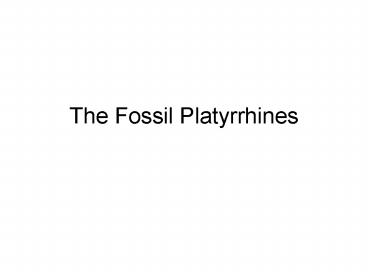The Fossil Platyrrhines - PowerPoint PPT Presentation
1 / 12
Title:
The Fossil Platyrrhines
Description:
Atelinae (spider, wooly, howler, wolly spider) Pithecinae (saki, bearded ... Largest monkey at La Venta. Resembles Alouatta (howler) The Miocene of Patagonia ... – PowerPoint PPT presentation
Number of Views:118
Avg rating:3.0/5.0
Title: The Fossil Platyrrhines
1
The Fossil Platyrrhines
2
Modern Platyrrhines
- Traditional Classification
- Cebidae
- Atelinae (spider, wooly, howler, wolly spider)
- Pithecinae (saki, bearded saki, uacari)
- Aotinae (owl monkey)
- Callicebinae (titi)
- Cebinae (capuchin squirrel)
- Callitrichidae
- Marmosets, tamarins lion tamarins
3
Platyrrhine Ecology
- All arboreal forms living in forests
- Small to medium size
- All diurnal except Aotus
- Retain P2 (DF 2-1-3-3)
- Callitrichids have lost M3 (DF 2-1-3-2)
- Tympanic ring fused to side of bulla
4
Pleistocene and Holocene of the Caribbean
- Cave deposits on several islands have
surprisingly yielded several taxa - Xenothrix from Jamaica
- Paralouatta from Cuba
- Antillothrix from Hispaniola
- Implications of these recent finds
- Much greater diversity than expected
- Recent extinctions due to human influence?
- Single or multiple dispersals from mainland to
Caribbean?
5
Pleistocene of Brazil
- Cave deposits have yielded several taxa
- Protopithecus, first found in 1830s with recent
skeleton found in 1990s - Caipora, from same deposits in NE Brazil
- Both are very large and resemble atelines
- Several extant NWM taxa also found in these caves
- Callithrix, Cebus and Alouatta
6
Late Miocene of La Venta
- In Colombian tropics, 13-12 mya
- Laventan SALMA
- Ca. 10 platyrrhine taxa with clear affinities to
modern families or subfamilies - Warm, tropical forested habitat
- Combination of archaic and modern mammals
7
Some NWMs from La Venta
- Lagonimico conclutatus
- A giant tamarin?
- Owl monkey sized (ca. 1 kg)
- Very reduced upper M3
- No hypocones on upper molars
- Stirtonia
- Largest monkey at La Venta
- Resembles Alouatta (howler)
8
The Miocene of Patagonia
- Southern Argentina and Chile
- Two biostratigraphic intervals identified
- Colhuehuapian SALMA is early Miocene (ca. 20
mya), mainly from Chubut province, Argentina - Dolichocebus, Tremacebus, Chilecebus, etc.
- Santacrucian is middle Miocene, from Santa Cruz
Province, Argentina (ca. 17 mya) - Soriacebus, Carlocebus, Homunculus
- Affinities with extant taxa are highly contested
9
The Earliest Platyrrhines
- From the late Oligocene of Bolivia
- Salla is the locality, Deseadan SALMA
- Branisella and Szalatavus are the genera
- Both have 2-1-3-3 DF and retain hypocones on
upper molars - Both probably primitive Platyrrhines without
clear connections to any single extant family or
subfamily
10
Origin of Platyrrhines
- A still unsolved puzzle with no easy answer
because S America was an island continent
thruout the Cenozoic - Rafting across an oceanic barrier is the only
(barely) plausible mechanism - Two major possible source areas
- North America
- Africa
11
North American Origin
- Cons
- No anthropoids known from N America
- Caribbean geology and plate tectonics is largely
unknown - Currents would not have been favorable
- Requires diphyletic origin of anthropoids
- Pros
- Shorter separating distance
12
African Origin
- Pros
- Fayum anthropoids in L Eocene - E Oligocene
- Possible island hopping scenario with lowered sea
level - Currents would have been favorable for E-W
dispersal - Allows monophyletic origin of anthropoids
- Ancestor of S American rodents also present at
Fayum - Cons
- Long ocean barrier
- Primates are not considered to be well-adapted
for long oceanic rafting trips, so this was a
low-probability event but it obviously must have
occurred!































